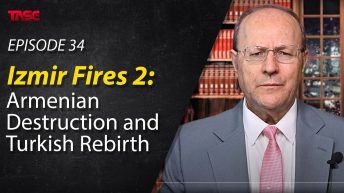In Episodes 1, 3, 5, 10, 24, and 25, I have documented extensively how the official Armenian narrative is based on a dishonest and racist interpretation of 1915 events. The highest court in Europe ruled on Dec 17, 2013, and then again on appeal on Oct 15, 2015, that the alleged Armenian genocide could not be compared to the Jewish Holocaust because the latter is backed by a verdict of a competent tribunal, namely the Nuremberg ruling of October 1, 1946. They asserted that genocide remains an opinion, not a court-proven fact, and rejecting such opinion is an exercise of the undeniable right of an individual to freedom of speech. Some Armenians, continuing to use History as a political tool, tried to concoct similarities between the Japanese-American internment during WWII and the long-discredited Armenian Genocide claim of WWI. In order to make sense out of such wild Armenian claims, we must take a closer look at what transpired during the Japanese-American internment. After the December 7, 1941 attack on Pearl Harbor, the FBI arrested 1,291 Japanese-American leaders without any evidence and froze their assets. The following day, President Franklin D. Roosevelt asked Congress to declare war on Japan, which they did by an almost-unanimous vote. In January 1942, the Japanese-Americans were transferred to prison camps in Montana, New Mexico, and North Dakota. They remained prisoners during the entire war. The FBI raided the private homes of thousands of Japanese American residents on the West Coast, seizing their assets like transistor radios and other items considered a risk for the US war effort. Some politicians in the Congress called for mass incarceration of Hawaii’s Japanese population. Japanese-owned fishing boats were impounded. Numerous Japanese-American residents were arrested and 1,500 of them were shipped to prison camps on the U.S. mainland. The incarceration of Japanese Americans is considered one of the most atrocious violations of American civil rights in the 20th century. Lt. General John L. DeWitt, leader of the Western Defense Command, determined to control the civilian population to prevent a repeat of Pearl Harbor. He prepared a report filled with well-known falsehoods. One such item, for example, was about sabotages to power lines that were later revealed to be caused by cattle. DeWitt suggested to Secretary of War Henry Stimson and Attorney General Francis Biddle creating military zones for Japanese detainment. His original plan also included Italians and Germans. At Congressional hearings in February 1942, most of the testimonies declared that all Japanese should be removed. President Roosevelt obliged and signed the order on February 19, 1942. Beginning on March 24, 1942, Japanese-Americans were given six days’ notice to dispense with their assets. Assembly Centers were mostly converted horse stalls or cow sheds. Food scarcities and poor sanitation were the order of the day. Prisoners could work as lowly laborers or do seasonal farm work. These prison camps, eerily called “Relocation Centers,” were some barracks with no running water shared by many families who ate their meals in vast mess halls. With no privacy, the families endured inhumane conditions throughout the remainder of the war. Each prison camp was surrounded by barbed wire, guard towers, and patrolled by armed guards who had instructions to shoot anyone who tried to leave. Some Japanese Americans were shot by guards while others died due to inadequate medical care and the severe emotional stresses. Fear, not evidence, provoked the U.S. to forcibly send some 127,000 innocent Japanese-Americans, most of whom lived on the Pacific Coast and two -thirds were United States citizens, to appalling concentration camps in the western interior of the country for the duration of WWII. In contrast, during WWI, the Ottoman-Armenians took up arms against their own government, rebelled, raided, bombed, murdered, plundered, terrorized their Muslim and Jewish neighbors in Anatolia. They aided, abetted and even joined the invading Russian enemy armies. The Ottoman government took the TERESET decision on May 27, 1915, to temporarily resettle some, not all, of the Armenians, just to protect the homeland. It was a wartime measure to mitigate a serious threat to homeland security and Ottoman war effort. Japanese posed no such threat and committed no war crimes in the US. Comparing the two, if not based on ignorance and gullibility, is absurd, dishonest, and racist. To learn more about the Supreme court rulings concerning Endo and Korematsu, please watch the clip.
Myths and Realities




Add comment